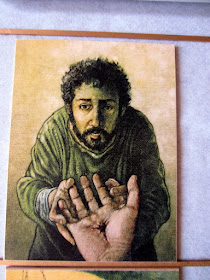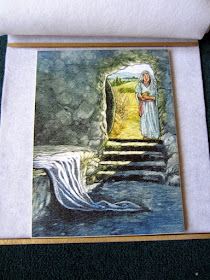Hi Godly Play Teachers!
Welcome to Knowing Jesus in a New Way 4: Known in the Morning, our lesson for May 3.There are several different things you may choose to emphasize to the children:
1. The miracle in the boat. The men had caught nothing on their own. But when Jesus was in charge, "they could feel all the fish moving into the nets." They were shocked to find that the man on the shore was Jesus, sitting by a campfire, cooking fish for their breakfast. With Jesus' direction, there were fish. Without it, no fish. What does this say to us?
2. Jesus' words of direction to Peter when Peter said he loved Jesus: "Feed my lambs." If we do love Jesus, we have our work cut out for us. Our job is to take care of each other. How would Jesus have us do that?
3. All through this story, Peter hasn't taken his eyes off of Jesus. But as he walks with Jesus, he turns around, sees John following them, and says, "Lord, what about him?" Jesus answers with,"If I want him to live until I come, what is that to you? Follow me!" To me, this is Jesus saying,"Keep your eyes on your own paper!" or don't worry about others and their relationships to me. Instead, think about your relationship to me.
4. Another thing that strikes me in this story is that Peter so often messes up, right after discovering some profound truth! He promises that he will never deny his Lord, and then denies him three times. He says, Yes I'll do your will, I'll feed your sheep...and then gets concerned about what John is doing. Yet Jesus loves and accepts him and even sees him as a leader, as fault-filled as he is. This gives me hope!
Wondering Questions:
.
1.I wonder what your favorite part of
this story is.
2. Jesus tells the men what to do in
the boat and they listen and suddenly they start catching fish. I wonder what we
can learn from that.
3.
I wonder how it felt to sit down for
breakfast with Jesus. I wonder what you would have said to Jesus if you were
sitting there.
J 4. Jesus tells Peter if he loves him to
feed his lambs. I wonder what this means.
I wonder who are the lambs.
I wonder what we do to take care of them.
5.
When Jesus and Peter are walking
together, Peter notices that John is following them. When Peter asks Jesus about
what will happen with John, Jesus tells him not to worry about John or others ,
but to concentrate on following Him. I wonder what we can learn from
that.
Ideas for the Children's Gift to God Time
Here's some ideas to get the kids started thinking about the work they choose to do around this story.
1. Retell the story through art.
*Could your class make a 3D scene of the story? Could someone build a boat out of clay or pieces of wood? Could someone else make a Jesus figure to sit or stand by a campfire on the shore? You'll need figures of the other disciples too. Kids could make these out of clothespins or paper. Could you use felt or paper to make the sea and the shore?
Or tell it through a video!
2. Make a Breakfast with Jesus mural/drawing/painting. What it you had been with Peter that morning? Could your kids draw themselves and their friends or family at the breakfast?
Here's how artist Karen Lucci imagines Jesus cooking breakfast.

How do your children imagine it? Paint or watercolor or draw the scene.
3. Who are Jesus' Lambs? Children could draw or make a collage from magazine photos of pictures of Jesus' lambs (people of all different ages and races)
4. How Do We Feed His Lambs? Kids could draw or make a collage about all the ways we can feed his lambs-ways we help each other.
5. Jesus Loves Me-Jesus shows Peter how much he loves him in this story, in spite of the 3 times he denied him, in spite of anything. The children could draw themselves with Jesus, writing or drawing what Jesus loves about them.
6. Kids could make "Fish stick" bible bookmarks-rectangular pieces of fun foam, with whatever scripture you choose. Have decorations on hand-stickers, sequins, markers, etc. Or how about beaded fish?
Thanks y'all!
Enjoy! (And take photos!)






















